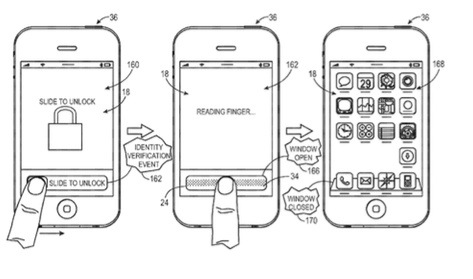An Apple patent (number 20120258773) for providing access to an internal component has appeared at the U.S. Patent & Trademark Office. Systems, methods, and devices are disclosed for concealing components of an electronic device.
In one embodiment, an electronic device may include a component that is disposed behind a window configured to selectively become transparent or opaque, such as a polymer-dispersed liquid crystal (PLDC) window. The component includes an image capture device, a strobe flash, a biometric sensor, a light sensor, a proximity sensor, or a solar panel, or a combination thereof.
Additionally, the electronic device includes data processing circuitry configured to determine when an event requesting that the component be exposed occurs. Furthermore, the electronic device includes a window controller that may control the window to become transparent, to expose the component upon the occurrence of the event requesting that the component be exposed.
Here’s Apple’s background on the invention: “The present disclosure relates generally to the industrial design of an electronic device and, more particularly, to techniques for hiding components of an electronic device behind a window, such as a polymer-dispersed liquid crystal (PDLC) window, while such components are not in use.
“Electronic devices are becoming more and more sophisticated, capable of performing a multitude of tasks from image capture to identity verification through biometric sensors. Providing increased functionality often involves adding components to such electronic devices. However, adding more components can lead to a cluttered, unattractive electronic device.
“Current techniques for incorporating components into an electronic device may be limited by the relative sizes of the components and the electronic device. The larger the components and the smaller the electronic device, the less spatial area there may be to incorporate additional components. For example, a small electronic device where a large display covers most of the face of the electronic device may not allow for any additional components, such as a fingerprint reader, to be added to the electronic device.
“Furthermore, under the current techniques, adding new components may harm the aesthetic appeal of the device by cluttering the electronic device enclosure, even though these additional components may be seldom or never used by many users. An electronic device that incorporates multiple components may lose its aesthetic appeal when covered by visible components, particularly as compared to a seamless electronic device where very few, if any, components of the electronic device are visible.”
The inventors are Felix Jose Rivera Alvarez, Richard Hung Minh Dinh and Scott A. Myers.
Also appearing today at the U.S. Patent & Trademark Office are:
° Patent number 20120260106 for systems, methods, and non-transitory computer-readable storage media for binary layout randomization;
° Patent number 20120260102 for systems, methods, and non-transitory computer-readable storage media for executing encrypted computer code;
° Patent number 20120257099 for a driver circuit for a camera voice coil motor (VCM);
° Patent number 20120254625 for protecting states of a cryptographic process using group automorphisms;
° Patent number 20120260115 for apparatuses and methods for implementing an inter-processor communication channel including power-down functionality;
° Patent number 20120260027 for systems and methods for using a NAND-type non-volatile memory (“NVM”), such as NAND flash memory, to store NV pre-boot information for a bootloader (e.g., a second state bootloader) or an operating system.;
° Patent number 20120257072 for systems, methods and computer-readable media for manipulating images using metadata;
° Patent number 20120256849 for region activation of a touch sensitive surface.

